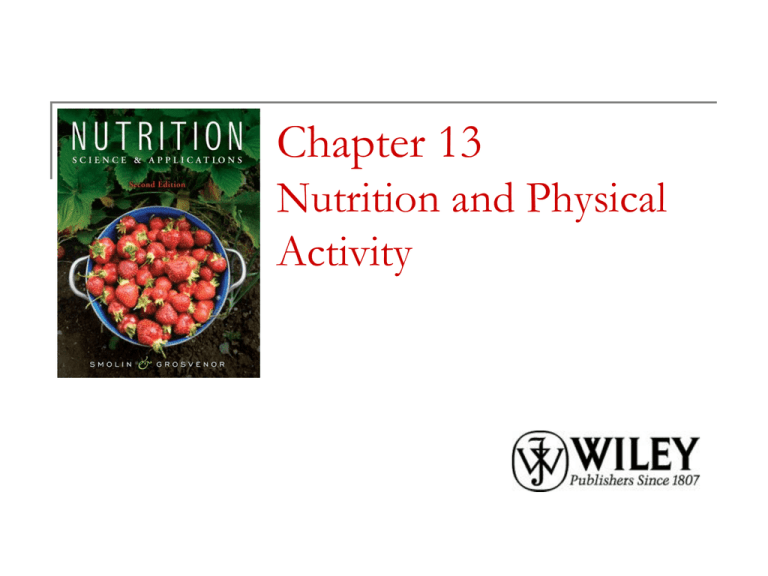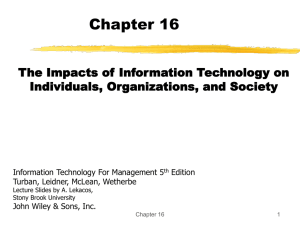
Chapter 13
Nutrition and Physical
Activity
Exercise, Health and Fitness
Fitness is defined as the ability to perform routine
physical activity without undue fatigue.
The overload principle assumes that the body will
adapt to the stresses placed on it.
Aerobic exercise includes endurance exercises such
as jogging, swimming or cycling, or any exercise that
increases heart rate and requires oxygen in
metabolism.
The cardiorespiratory system includes the circulatory
and respiratory systems, delivering oxygen and
nutrients to the cells.
Copyright 2010, John Wiley & Sons, Inc.
Exercise, the Heart and the Muscles
Regular aerobic exercise strengthens the heart muscle, increases
stroke volume and decreases the resting heart rate.
The resting heart rate can be measured by counting the number of
pulses per minute while at rest.
Aerobic capacity is the body’s maximum ability to generate ATP
by aerobic metabolism during exercise. Aerobic capacity is also
called VO2 max.
Stress or overload during exercise causes muscles to adapt by
increasing in size and strength. This is called hypertrophy.
When muscles are not used, they atrophy, becoming smaller and
weaker.
Exercise builds and maintains muscles. People who are fit have a
greater proportion of lean body tissue than those who are not fit.
Copyright 2010, John Wiley & Sons, Inc.
Health Benefits of Exercise
In addition to increased flexibility and the
ability to easily perform daily activities,
benefits of regular exercise include:
Weight management
Cardiovascular health
Diabetes prevention or management
Bone and joint health
Possible reduction of cancer risk
Psychological health
Copyright 2010, John Wiley & Sons, Inc.
Exercise Recommendations
Copyright 2010, John Wiley & Sons, Inc.
Target Heart
Rates During
Aerobic
Exercise
Copyright 2010, John Wiley & Sons, Inc.
Components of a Good Exercise
Regimen
Copyright 2010, John Wiley & Sons, Inc.
Suggestions for Starting and Maintaining
an Exercise Program
Copyright 2010, John Wiley & Sons, Inc.
Fueling Exercise
Aerobic metabolism is metabolism in the presence of
oxygen. Glucose, fatty acids and amino acids are
completely broken down to form CO2 and H20 and to
produce ATP.
Anaerobic metabolism is metabolism in the absence
of oxygen. Each molecule of glucose produces two
molecules of ATP. Glucose is metabolized in this way
when oxygen cannot be supplied quickly enough to the
tissues to support aerobic metabolism.
Anaerobic metabolism is also called anaerobic
glycolysis.
Copyright 2010, John Wiley & Sons, Inc.
Fueling Exercise by the Minute
Copyright 2010, John Wiley & Sons, Inc.
The Process of Anaerobic Metabolism
Copyright 2010, John Wiley & Sons, Inc.
The Effect of Exercise Intensity
Copyright 2010, John Wiley & Sons, Inc.
Nutrient Needs for Physical Activity
Copyright 2010, John Wiley & Sons, Inc.
Relationship of Exercise to Intake
The source of dietary energy can be as important
as the amount of energy in an athlete’s diet.
Vitamins and minerals requiring special attention
from athletes:
B vitamins
Antioxidant vitamins, such as vitamins C and E
Iron
Calcium
The general proportion of energy for athletes and
healthy individuals should be:
45-65% total energy from carbohydrates
20-35% from fat
10-35% from protein
Copyright 2010, John Wiley & Sons, Inc.
Fluid Needs for Physical Activity
During exercise, water is needed to eliminate heat, to
transport oxygen and nutrients to the muscles and to remove
waste products such as lactic acid from the muscles.
The ability to dissipate heat depends on hydration levels.
At rest in a temperate climate, an adult loses about 4½ cups
of water per day through evaporation from the skin and
lungs.
Even with regular consumption, it may not be possible to
consume sufficient fluid to remain properly hydrated.
Failure to compensate for fluid losses can result in
dehydration.
If heat cannot be lost from the body, body temperature rises
and exercise performance as well as health can be
jeopardized.
Copyright 2010, John Wiley & Sons, Inc.
Fluid Needs for Physical Activity
Dehydration occurs when water loss is great enough for
blood volume to decrease.
Dehydration reduces the body’s ability to deliver oxygen
and nutrients to muscles.
Copyright 2010, John Wiley & Sons, Inc.
Hyponatremia
Copyright 2010, John Wiley & Sons, Inc.
Heat-Related Illnesses
Copyright 2010, John Wiley & Sons, Inc.
Recommended Fluid Intake
Copyright 2010, John Wiley & Sons, Inc.
Food and Beverages to Maximize
Performance
Copyright 2010, John Wiley & Sons, Inc.
What Are You
Getting From
That Sports
Bar?
Copyright 2010, John Wiley & Sons, Inc.
Impact of Diet versus Supplements
Copyright 2010, John Wiley & Sons, Inc.
Chapter 13
Copyright 2010 John Wiley & Sons, Inc.
All rights reserved. Reproduction or translation of this work beyond
that permitted in section 117 of the 1976 United States Copyright Act
without express permission of the copyright owner is unlawful.
Request for further information should
be addressed to the
.
Permissions Department, John Wiley & Sons, Inc. The purchaser may
make back-up copies for his/her own use only and not for distribution
or resale. The Publisher assumes no responsibility for errors,
omissions, or damages caused by the use of these programs or from
the use of the information herein.
Copyright 2010, John Wiley & Sons, Inc.




